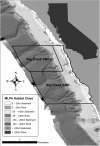Assessment of habitat representation across a network of marine protected areas with implications for the spatial design of monitoring
- PMID: 25760858
- PMCID: PMC4356544
- DOI: 10.1371/journal.pone.0116200
Assessment of habitat representation across a network of marine protected areas with implications for the spatial design of monitoring
Abstract
Networks of marine protected areas (MPAs) are being adopted globally to protect ecosystems and supplement fisheries management. The state of California recently implemented a coast-wide network of MPAs, a statewide seafloor mapping program, and ecological characterizations of species and ecosystems targeted for protection by the network. The main goals of this study were to use these data to evaluate how well seafloor features, as proxies for habitats, are represented and replicated across an MPA network and how well ecological surveys representatively sampled fish habitats inside MPAs and adjacent reference sites. Seafloor data were classified into broad substrate categories (rock and sediment) and finer scale geomorphic classifications standard to marine classification schemes using surface analyses (slope, ruggedness, etc.) done on the digital elevation model derived from multibeam bathymetry data. These classifications were then used to evaluate the representation and replication of seafloor structure within the MPAs and across the ecological surveys. Both the broad substrate categories and the finer scale geomorphic features were proportionately represented for many of the classes with deviations of 1-6% and 0-7%, respectively. Within MPAs, however, representation of seafloor features differed markedly from original estimates, with differences ranging up to 28%. Seafloor structure in the biological monitoring design had mismatches between sampling in the MPAs and their corresponding reference sites and some seafloor structure classes were missed entirely. The geomorphic variables derived from multibeam bathymetry data for these analyses are known determinants of the distribution and abundance of marine species and for coastal marine biodiversity. Thus, analyses like those performed in this study can be a valuable initial method of evaluating and predicting the conservation value of MPAs across a regional network.
Conflict of interest statement
Figures







References
-
- Halpern BS, Kappel CV, Selkoe KA, Micheli F, Ebert CM, et al. (2009) Mapping cumulative human impacts to California Current marine ecosystems. Conserv Lett 2(3): 138–148.
-
- Lester SE, McLeod KL, Tallis H, Ruckelshaus M, Halpern BS, et al. (2010) Science in support of ecosystem-based management for the US West Coast and beyond. Biol Conserv 143: 576–587.
-
- Douvere F (2008) The importance of marine spatial planning in advancing ecosystem-based sea use management. Mar Policy 32: 762–771.
Publication types
MeSH terms
LinkOut - more resources
Full Text Sources
Other Literature Sources

